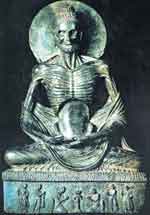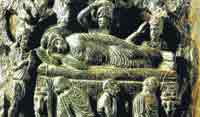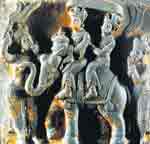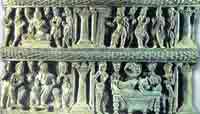|
By
Chandani Kirinde
The fact that the great Buddhist civilization better known as the
Gandhara civilization held sway in the north-western region of present-day
Pakistan is known to many. But one can only begin to fathom the
real glory and extent of this civilization by visiting the sites,
many of which the world is yet to see.
This could change now with the Government of Pakistan keen to attract
tourists worldwide to share with them that fascinating aspect of
the country. An aspect that has been overshadowed by political upheavals
and terrorism that have plagued the area, and which unfortunately
have become more symbolic of this part of the world than its arts
and culture.

Fasting
Buddha found at Taxila now in the Lahore Museum |
The Gandhara civilization flourished in the north-western region
of Pakistan from the 6th Century BC to the 5th Century AD and the
main purpose of the arts of that time was to propagate Buddhism
through images carved in stone, stucco, terracotta and bronze. These
were mostly enshrined in monasteries and stupas throughout the Gandhara
region.
The Gandhara School of Art is credited by many, as being the first
creators of the Buddha in human form, rather than as a symbol –
the method which was adopted before the Gandhara period. Some of
these early interpretations of the Buddha included His footprint.
What would enthral any visitor to the region would be the sight
of well preserved pieces of art which depict the life story of the
Buddha -- conception, birth, enlightenment and death; His previous
birth stories- (the Jathakas) as well as images of the future Buddhas.
Gandhara art is a mix of many cultures and the dedicated artists
of the era painstakingly carved out the life story of the Buddha
mixing Greek, Persian, Indian and Roman schools of art. It was from
here that Buddhism travelled to China, Korea and Japan.

Mahaparinirvana
of the Buddha (2ndC AD) at the Peshawar Museum |
Buddhism
was introduced to Gandhara by the great Indian King Asoka around 256
BC. Later under the reign of Kanishka - the Kushana emperor who ruled
Purushapura (now Peshawar in northern Pakistan) from around 127 AD
for more than 20 years, Buddhism further flourished. Emperor Kanishka
sent missions to distant lands.
The actual territory of Gandhara is a triangular piece of land about
100 kilometres, east to west and 70 kilometres north to south, on
the west side of the Indus river, surrounded by mountains. But the
expansion of Gandhara art crossed geographical limits and covered
an area from Eastern Afghanistan, Taxila, the modern day Swat valley,
Dir, Malakand, Mardan and Peshawar valley to Kashmir.

Transportation
of relics (2nd-3rdC AD) at Islamabad Museum |
Many
Sri Lankans are familiar with Taxila as a seat of learning in ancient
times. Taxila, situated about 35 km north-west of Pakistan’s capital
of Islamabad was the main centre of Gandhara, dating back to over
3,000 years ago. It had attracted Alexander the Great from Macedonia
in 326 BC, who brought Greek culture to this part of the world.
It later came under the Mauryan dynasty and reached its highest
level of development under Emperor Asoka who during the 2nd Century
BC adopted Buddhism as the state religion, which flourished and
prevailed for over 1,000 years, until the year 10 AD. It was during
this time that Taxila along with other cities became important centres
of culture, trade and learning.
A journey from Taxila to the Swat Valley up to Peshawar up to the
Khyber Valley, along the ancient trail of Buddhist civilisation
is bound to fascinate anyone irrespective of their religious beliefs.
But for a Buddhist it is a pilgrimage to a holy land where the pace
of life seems to go on in the same manner in which it probably did
when the great Buddhist civilization thrived. Hundreds of stupas
and monasteries were erected in Gandhara and many of the artefacts
uncovered today are well preserved and protected in several museums
including the museums in Dir, Peshawar and Lahore. The Peshawar
museum takes pride of place among these with a collection of Gandhara
art including about 1000 pieces of Buddhist sculpture.

Birth
of Prince Siddhartha (2nd-3rdC AD) at Peshawar Museum
|
Other than the museum, some of the original sites where stupas and
monasteries were built can be seen as well. Many of these are in
remarkably good condition. The Dharmarajika stupa and monastery
founded by Emperor Asoka is one such site. Hundreds of Buddhist
monks are believed to have resided here and many Buddhist and non
-Buddhist sculptures have been recovered dating back to between
the 3rd Century BC and 5th Century AD.
The Juliana stupa and monastery in Taxila are also two well preserved
Buddhist monuments. The monastery is believed to have been a double
storey complex but only a part of it remains intact now. Yet the
stone carvings of the life story of the Buddha can be seen in its
remnants.
Swat in Saidu Sharif about 258 kilometres north of Islamabad is
another place where Buddhism had flourished and had been a place
of pilgrimage for many hundreds of years before the religion began
to decline around the 10th Century AD. There are more than 400 Buddhist
sites covering an area of 160 km in Swat valley.
Another fascinating place on the Buddhist trail is the well preserved
Buddhist monastery at Takht-i-Bhai, about 156 km north of Islamabad
dating back to between the 2nd and 5th Century BC. The existing
buildings include the main stupa, two courtyards in different terraces,
cells for meditation for Buddhist monks as well as several stone
figures of the Buddha.
These are but a handful of what Gandhara art achieved during its
days of glory. The archaeological authorities in Pakistan are unearthing
more and more wonders from these sites each day.

Dream
of Queen Mahamaya (1st-2ndC AD) |
Starting
from this cradle of Buddhist civilization, the Gandhara Buddha moved
onto central Asia taking a message of peace influencing millions
of people in the ancient world. And even though Buddhism may not
be practised throughout the region anymore, the universally accepted
message of compassion preached by Lord Buddha comes to the mind
of anyone fortunate enough to walk the trail of the greatest Buddhist
civilization the world has known.
|




